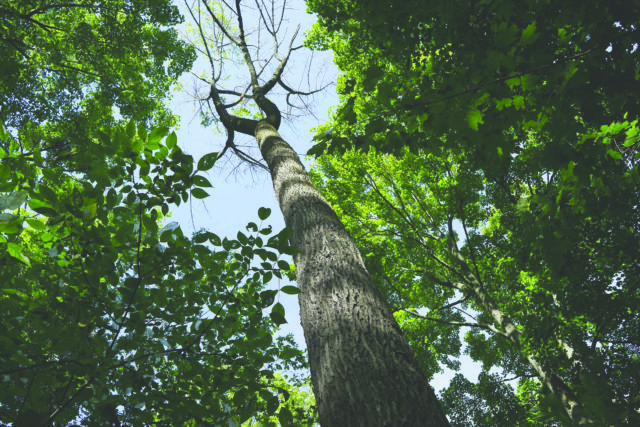
This story starts in Asia. The main character is a tiny metallic green insect, known to English ears as the Emerald Ash Borer (EAB). No one is exactly sure when, or how, this penny-sized insect made its way across the Atlantic Ocean, over the Rocky Mountains and onto the western shores of Lake Erie in southeast Michigan — but one day, sometime during the 1990s, a fleet of EABs did, and the insects decided to stay.
By the turn of the century, a mysterious die-off was underway in southeast Michigan’s deciduous forests. Ash trees (those neighborly looking giants with unruly bright-green fringe) were dying left and right. Brittle and weakened, they’d snap and crash down, tearing through power lines and residential structures, blocking roads and causing millions of dollars in damages.
EAB larvae, it turns out, love to dig tunnels and feed from the ashes’ inner bark, disrupting the upward flow of nutrients and water, slowly starving and suffocating the trees.
Over the next decade, EABs spread their territory southward and east. Around 2013, a few EABs hitchhiked their way west, across the central plains, to central Boulder.
“We don’t know who did it or exactly when, but it would have had to have been in firewood,” says Laura Pottorff, leader of the EAB response team at the Colorado Department of Agriculture (CDA). “We assume that every ash tree in Boulder may have [an EAB infestation] now.”
That’s approximately 70,000 trees, or about 25% of Boulder’s urban canopy, according to the City’s Urban Forest Strategic Plan.
Until August, Boulder County was the only known Colorado county to contain EABs. The insects, however, moving about half-a-mile a year, spread uncontrollably. Within three years of landing in Boulder, Longmont reported EAB sightings. In 2018, Superior trees started showing telltale signs. The latest to join the club is Broomfield: Earlier this month, national and state experts confirmed the city’s first EAB infestation.
After two decades of ash destruction in the U.S., experts are confident there’s no stopping the spread of EABs. It’s only a matter of time before they move into the Denver metro area and infect the 1.45 million ash trees there. As Kristen Anderson, a horticulture expert from Colorado State University’s Boulder County Extension Program, puts it, “This is essentially an [ash] extinction event.”
Losing 25% of Boulder’s foliage will have serious implications, including rising city temperatures, worsening air quality and other plant degradation. Thus, replacing ash trees has been the County’s primary focus and the main messaging of the recently launched “Boulder’s Tree Crisis 2019” campaign.
“We understand that we can’t eradicate [EABs],” says Pottorff. “But there are a lot of tools we have to help us slow it down and manage.”
If property owners determine an ash tree is growing on their property, they have a few options, following a health assessment of the tree.
Signs of EAB infestation include thinning leaves in the upper tree canopy, eighth-inch D-shaped holes on the surface of the bark and winding S-shaped tunnels underneath. Any suspected EAB infestations should be reported to the CDA, where experts can help precisely determine the state of the tree’s health and advise property owners on best next steps.
If less than one-third of the tree is damaged, it may be treatable with pesticides, Pottorff says. But only if the property owner is particularly attached to the tree. “If your tree is worthy — meaning you can afford it, it’s valuable to your property and if the tree’s in good condition — then certainly insecticide application is an option.”
But, if your tree is “already past the point of no return” — which is highly possible in Boulder County — Anderson says it should be replaced.
Locally, between Sept. 15 and Oct. 31 is the best time to plant a new tree.
Over the course of fall 2019, Boulder County’s Ash Tree Removal Project plans to remove sickly trees in ten “project areas,” including most notably a cluster on Heatherwood Drive and almost 100 trees along Carter Trail in Gunbarrel.
Because tree replacement and insecticide treatments are both expensive, Boulder County has rolled out an ash tree adoption program to help treat, in perpetuity, “worthy” public trees for EAB infections. Folks can apply for tree adoption at bouldercountyeab.org, and learn more about personal tree treatment options.
Several people have already taken advantage of the adoption program, says Anderson. Some hope to keep privacy barriers or shade in their yards, others simply enjoy their aesthetic value. “People are really connected to trees, even if they’re not your actual property, they’re an asset to your life,” says Anderson.
More than anything, Anderson says, “Don’t wait to decide to either treat your tree or take it out. Ash trees are very brittle and when they fail, they fail.”














